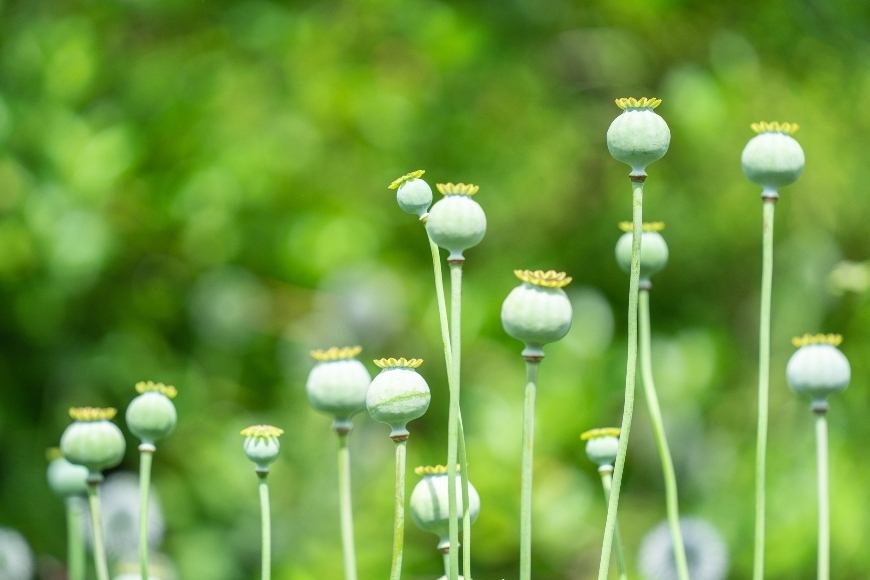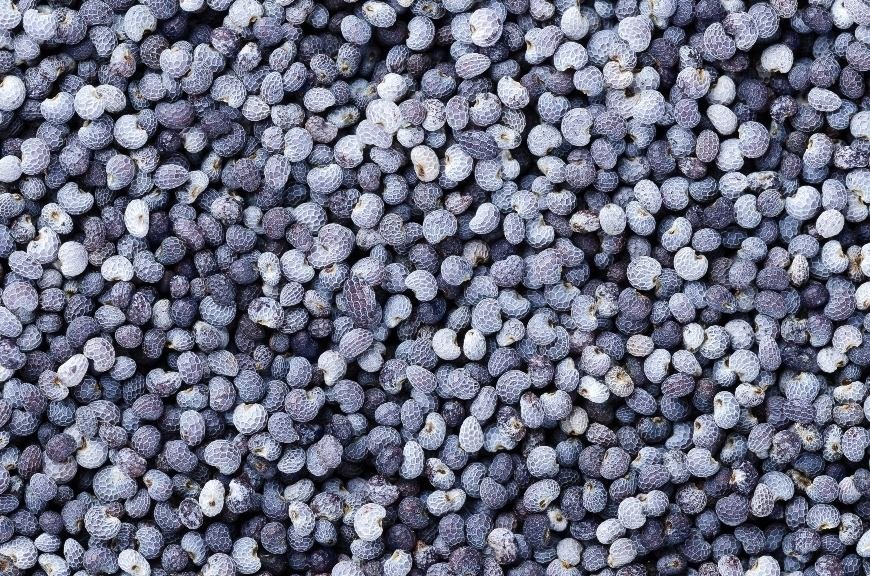What is Opium Poppy?
Learn about Opium Poppy as we explore its history, alkaloids, morphine content, and legality in this informative blog post.

What is Opium Poppy? A fascinating plant with a rich history and complex chemistry, the opium poppy (Papaver somniferum) has been both revered and feared for its potent effects. This blog post will investigate the past of this enigmatic plant, from its domestication to the numerous alkaloids it contains.
We'll explore how different varieties of Papaver somniferum contain varying levels of morphine content and other key alkaloids such as codeine and thebaine. Additionally, we'll discuss potential health risks associated with consuming untreated poppy seeds that may have implications on drug testing results.
As concerns about morphine content in food products grow, we will examine measures taken by countries like Germany to regulate poppy seed usage. Finally, legality and safety concerns surrounding opium poppy cultivation and recreational use will be addressed to provide a comprehensive understanding of what is Opium Poppy?
Table of Contents:
- The Origins and History of Opium Poppy
- Domestication and Spread of Papaver somniferum L.
- Neolithic Archaeological Discoveries
- Alkaloids Found in Opium Poppy
- Effects of Consuming Poppy Seeds on Health
- Measures Taken to Reduce Morphine Content in Food Products
- Legality and Safety Concerns Surrounding Opium Poppy
- FAQs in Relation to What is Opium Poppy?
- Conclusion
The Origins and History of Opium Poppy
The opium poppy, scientifically known as Papaver somniferum L., has a long history stretching back over 5 millennia. It has been domesticated in western Europe and originates from the Near East. Archaeological evidence of opium poppy remains can be found at 40 sites across temperate Europe, including Bucheres - a multiperiod site where capsules containing opium poppies from the Neolithic period were identified.
Domestication and Spread of Papaver somniferum L.
Opium poppies have been cultivated for their medicinal properties since ancient times. The earliest records of its use come from Sumerian clay tablets dated around 3,400 BC that mention "Hul Gil," or "joy plant." From there, it spread to various parts of the world like Egypt, Persia (modern-day Iran), Greece, Rome and eventually reached China through trade routes such as the famous Silk Road. Its popularity grew due to its powerful pain-relieving effects provided by alkaloids like morphine found within its unripe seed capsule.
Neolithic Archaeological Discoveries
In recent years, numerous archaeological findings have shed light on how widespread the cultivation and usage of opium poppies were during prehistoric times. For instance:
- Ancient burial sites in Spain contained traces of Papaver setigerum, a close relative to Papaver somniferum with similar alkaloid content.
- Remnants of poppy seeds were discovered in a Neolithic site located in Switzerland, dating back to around 3,800 BC.
- A Bronze Age burial site in England contained a ceramic vessel with traces of opium alkaloids and poppy seed remains, suggesting its use for medicinal or ritual purposes during that time. This discovery was published in the journal The Holocene.
These findings not only highlight the historical significance of opium poppies but also demonstrate how their cultivation and usage have been deeply ingrained within various cultures throughout history.
Alkaloids Found in Opium Poppy

The opium poppy, Papaver somniferum L., is known for its rich content of various alkaloids that have been used medicinally throughout history. The plant contains three important alkaloids: morphine, codeine, and thebaine. These compounds are responsible for the potent pain-relieving properties associated with this fascinating plant.
Morphine Content in Different Varieties
Different sub-varieties of Papaver somniferum L. exhibit varying levels of morphine content. Morphine, an opioid derived from the opium poppy, is renowned for its pain-relieving properties and has been used medicinally for centuries. It has been utilized for centuries to provide unrivaled relief from severe pain associated with conditions such as myocardial infarction and acute left ventricular failure (source). However, it's essential to note that levels tend to be lower than those previously reported by Sproll et al. (2006).
Codeine Composition Variations
In addition to morphine, codeine is another vital alkaloid found within opium poppies. Codeine serves as a less potent analgesic compared to morphine but still offers effective pain relief when appropriately administered (source). Like morphine's concentrations, different varieties of Papaver somniferum L. can also contain varying amounts of codeine depending on factors like growing conditions and genetic makeup.
Role of Thebaine
The third key alkaloid found in opium poppies is thebaine. While it does not possess significant analgesic properties, thebaine serves as a precursor for synthesizing other opioids such as oxycodone and buprenorphine. This makes it an essential component in the production of various pharmaceuticals used to manage pain.
Understanding these alkaloids' roles within Papaver somniferum L. helps us appreciate both their historical significance and modern-day applications. However, given their potential for abuse and addiction, it's crucial to exercise caution when using products derived from this plant species. Poppy seeds, unripe seed capsules, and other parts of the plant can contain varying amounts of these alkaloids, so it's essential to be aware of the risks associated with their use.
The alkaloids found in opium poppy are incredibly diverse and complex, but the primary compounds of interest include morphine, codeine, and thebaine. Considering the potential impacts of consuming opium poppy seeds on one's health is a critical element in this discussion.
Effects of Consuming Poppy Seeds on Health
The opium poppy plant (Papaver somniferum) produces poppy seeds that are commonly used in various dishes and baked goods. However, it's important to be aware of the potential health risks associated with consuming these tiny seeds.
Potential Risks Associated with Untreated Seeds
Poppy seeds contain natural opiates like morphine or codeine, although in small amounts. If not treated properly before use, they can be sources of morphine poisoning. While severe poisoning cases are rare, consuming large quantities or improperly processed seeds could lead to symptoms such as drowsiness, respiratory depression, and even coma in extreme cases.
Impact on Drug Testing Results
A study using High-Performance Liquid Chromatography (HPLC) revealed that consuming poppy seeds could result in positive opiate drug test outcomes due to their natural composition containing opiates like morphine or codeine. In some instances, individuals who consumed food products containing poppy seeds were found to have urinary concentrations exceeding cutoff values for opiate testing. Many organizations and institutions advise against consuming poppy seed-containing foods before drug tests.
- Morphine: Morphine is an opioid analgesic that acts directly on the central nervous system (CNS) to relieve pain. The primary alkaloid in opium poppy seeds is morphine.
- Codeine: Codeine is a weaker opioid analgesic than morphine and is often used as a cough suppressant or for mild-to-moderate pain relief. Like morphine, it can be found in small amounts within poppy seeds.
To reduce the risk of adverse effects, proper processing methods should be employed when using poppy seeds. Individuals who may undergo drug testing should avoid consuming poppy seed-containing foods before their tests.
Measures Taken to Reduce Morphine Content in Food Products

In recent years, there has been growing concern about the morphine content in poppy seeds used for culinary purposes. In response to the increasing worry over morphine content in poppy seeds, some nations have instituted protocols to make sure that levels of this powerful alkaloid remain within acceptable boundaries.
German Regulations on Poppy Seed Usage
Germany is one such country that has taken steps to regulate the use of poppy seeds in food products. The German Federal Institute for Risk Assessment (BfR) established guidelines stating that morphine content should not exceed 20 micrograms per gram (µg/g) in unprocessed poppy seeds and 10 µg/g in processed foods containing these seeds. These regulations aim to minimize potential health risks associated with consuming high levels of morphine from everyday food items like bread rolls or pastries.
Health Concerns Related to Morphine Levels
Morphine, an alkaloid found naturally in opium poppies (Papaver somniferum L.), can cause various side effects when consumed at high doses. Some common symptoms include drowsiness, nausea, vomiting, constipation, respiratory depression, and even addiction. By reducing the allowed morphine content in food products containing poppy seeds:
- The risk of accidental overdose is minimized;
- Potential negative impacts on sensitive individuals such as pregnant women or children are mitigated; and
- The likelihood of false-positive results during drug testing procedures is reduced.
It is important to note that while these measures are in place, the responsibility of ensuring safe consumption ultimately lies with food manufacturers and consumers alike. By being aware of the potential risks associated with poppy seeds and adhering to established guidelines, we can enjoy their culinary benefits without compromising our health.
The measures taken to reduce morphine content in food products have been successful, however there are still some legal and safety concerns surrounding opium poppy that need to be addressed. To gain a better comprehension of these matters, let us explore the laws and risks associated with opium poppy growth and recreational utilization.
Legality and Safety Concerns Surrounding Opium Poppy
Despite its historical medicinal uses and cultural significance, it is crucial not to promote or encourage recreational consumption of opium poppies due to their potentially harmful effects on users' health as well as legal implications surrounding possession and distribution. While research continues into understanding this plant's properties further, current knowledge underscores both its importance throughout history and caution needed when handling or ingesting any part of it today.
Legal status of opium poppy cultivation
The legality of cultivating Papaver somniferum, the opium poppy, varies from country to country. In the US, cultivating Papaver somniferum requires a license from the DEA due to its controlled substances like morphine and codeine. This is because they contain controlled substances such as morphine and codeine that can be extracted for illicit drug use. However, in other countries like Australia and Canada, growing opium poppies for ornamental purposes may be allowed under certain conditions. It is essential to check your local laws before attempting to cultivate this plant at home.
Risks associated with recreational use
While there are legitimate medical applications for opiates derived from the alkaloids found in Papaver somniferum, using them recreationally poses significant risks:
- Addiction: Opiates have a high potential for addiction due to their ability to produce feelings of euphoria along with pain relief. Prolonged use can lead individuals down a path towards physical dependence on these drugs.
- Overdose: Consuming excessive amounts of opiates can result in respiratory depression which may ultimately prove fatal if left untreated. Combining opiates with other substances such as alcohol or benzodiazepines further increases the risk of adverse health effects and potential overdose.
- Adverse health effects: Long-term opiate use can lead to a range of health issues, including liver and kidney damage, hormonal imbalances, and mental health problems like depression and anxiety.
Given the risks associated with opium poppy plant use, it is essential to exercise caution and consult a healthcare professional for appropriate treatment options. For those seeking relief from pain or other medical conditions, consulting a healthcare professional for appropriate treatment options is always recommended over self-medicating with potentially dangerous substances.
FAQs in Relation to What is Opium Poppy?
What is Opium Poppy?
Opium poppy, scientifically known as Papaver somniferum, is a flowering plant native to Western Asia and Southeastern Europe. It is cultivated for its seeds and latex, which contains powerful alkaloids like morphine and codeine used in pain relief medications. The dried latex from unripe seed capsules produces raw opium.
Interesting Facts about Opium Poppy
Opium poppy has been used for medicinal purposes since ancient times. Evidence suggests its use dates back to 3400 BC in Mesopotamia, where it was called Hul Gil or "joy plant." Today, derivatives of the plant are still widely utilized in modern medicine.
What is Opium Poppy Derived From?
Opium poppy derives from the Papaveraceae family of plants. The potent substances found within this species come primarily from its latex - a milky fluid extracted by making incisions on unripe seed capsules. This process yields raw opium containing various psychoactive alkaloids such as morphine, codeine, and thebaine.
Opium Poppy vs. Poppy Seeds
While both terms refer to plants belonging to the Papaver genus within the Papaveraceae family, "opium poppy" specifically refers to Papaver somniferum - a species with high concentrations of narcotic compounds like morphine and codeine. In contrast, "poppy seeds" refer to the small, kidney-shaped seeds of the opium poppy, as well as other species such as Papaver setigerum and Papaver orientale. These seeds are commonly used in cooking and baking.
Conclusion
For centuries, the opium poppy plant has been utilized for its medicinal benefits. It contains compounds such as morphine and codeine, which can have both short-term and long-term effects on the body. While opium poppy can be beneficial when used under medical supervision, it also carries significant risks of addiction and dependence.
In this piece, we investigated the background of opium poppy use, its impacts on the body, possible adverse effects, safety concerns and legal status. We hope you have obtained a more profound comprehension of opium poppy and its potential effects on your wellbeing.




































































































































